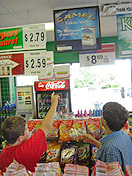News
Study counters tobacco industry claims
-
 Print
Print -
 Comments
Comments
-

A UB-Roswell Park study has found that banning tobacco advertising within 1,000 feet of schools would affect less than half of retail outlets that sell tobacco products.
For years the tobacco industry has argued that efforts to ban tobacco advertising near schools would constitute a total ban on tobacco advertising in urban areas.
But public health researchers at UB and Roswell Park Cancer Institute have presented research that shows this is not the case in Buffalo and Niagara Falls.
According to the tobacco industry’s argument, the area around schools in urban areas comprises a significant percentage of land area and population that would be off limits to tobacco advertisements if an advertising ban were in place.
“The tobacco industry has stated that a tobacco advertising ban within a 1,000-foot buffer zone near schools in urban areas would be equivalent to a total ban on advertising and would, therefore, be unconstitutional on First Amendment grounds,” explains Andrea Licht, a doctoral candidate in the Department of Social and Preventive Medicine, School of Public Health and Health Professions. Licht is first author on the study, which was presented in a poster session last month at the annual meeting of the Society for Research on Nicotine and Tobacco.
“However, based on our analyses, a law banning tobacco advertising within 1,000 feet of schools would affect fewer than half of their outlets,” she says. “We also found that only about one-third of the population potentially lives within this 1,000-foot buffer zone, so such an advertising ban would not act like a ‘de facto’ ban, as industry has claimed.”
During 2009-10, the years covered by the study, there were 350 tobacco retail outlets—convenience stores, groceries, delis, etc.—and 104 schools located in the city of Buffalo.
The study found that 17.3 percent of schools in Buffalo have a tobacco retail outlet located within 500 feet, while 49.9 percent have a tobacco retail outlet located within 1,000 feet and 71.2 percent of schools have a tobacco retail outlet located within 1,500 feet.
In Niagara Falls, there were 65 tobacco retail outlets and 15 schools. Of those 15 schools, 13.3 percent have a tobacco retail outlet located within 500 feet, 33.3 percent have a tobacco retail outlet within 1,000 feet and 46.7 percent have a tobacco retail outlet within 1,500 feet.
“The proximity to schools is significant because smoking patterns are almost exclusively developed during the adolescent and teen years,” Licht explains.
“These outlets near the schools and in lower-income areas may be more likely to be frequented by adolescents, young adults and other disadvantaged populations,” says Licht. “Since availability, accessibility and the perception that smoking is normal are all associated with higher youth-smoking rates, it is likely that advertising bans near schools may serve to reduce youth smoking initiation.”
Tobacco-outlet information for the study was collected and analyzed at RCPI for, and with, the help of the Erie-Niagara Tobacco-Free Coalition.
Co-authors with Licht are Anthony G. Billoni, director of the Erie-Niagara Tobacco-Free Coalition; K. Michael Cummings, UB professor of social and preventive medicine and chair of the Department of Health Behavior at RPCI; Andrew J. Hyland, UB research associate professor, Department of Social and Preventive Medicine, and associate member, Department of Health Behavior at RPCI; and Deborah Pettibone, media specialist with the Erie-Niagara Tobacco-Free Coalition.

Reader Comments